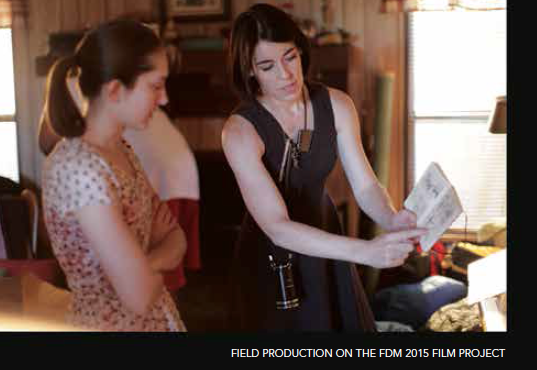Baylor’s nationally recognized film and digital media program is using a timely gift to expand its offerings
By Randy Fiedler
As graduates of Baylor’s film and digital media (FDM) program continue to expand their influence in the American entertainment industry, the University is using the generosity of an alumnus and his family to greatly enhance learning opportunities for the next generation of Baylor filmmakers.
In May 2015, Baylor announced that FDM alumnus Matthew B. Lindner (BA ’12) and his father, Carl H. Lindner III, of Cincinnati, Ohio, had given a gift of $2 million to create the Matthew B. Lindner Endowment for Excellence in Film and Digital Media. Each man gave $1 million as part of the collective gift.
“The faculty members in Baylor’s film and digital media program provided me with the kind of well-rounded education I needed to turn a love for film into the reality of a professional career in movies,” said Matthew Lindner, now a producer and investor in the independent film industry. “Words can’t describe the impact Baylor had on me, and I’m very happy to give back in some way. My hope is for Baylor to one day be known as one of the best film departments in the nation.”
Matthew’s father Carl serves as the co-CEO of American Financial Group Inc., a Fortune 500 Company. Carl Lindner and his wife Martha are graduates of the University of Cincinnati, where they met. Besides their interest in the Baylor FDM program, the couple has provided substantial support to the Global Mission Leadership Initiative in Baylor’s Diana R. Garland School of Social Work.
“I am very pleased to come alongside Matthew in supporting Baylor’s film and digital media program as it seeks to advance the Christian values of Baylor University and make a difference in the world through film and other forms of media,” Carl Lindner said. “Matthew’s love of Baylor, his passion for his chosen profession and his philanthropic efforts as a young man have inspired me and provide a wonderful example to the Baylor family.”
A higher profile
The creation of the Lindner Endowment has enabled Baylor to achieve its goal of giving film and digital media a higher profile. Once classified as a program under the Department of Communication, the endowment funds made it possible to elevate the program into a separate Department of Film and Digital Media on June 1, 2015. Chris Hansen, the associate professor of film and digital media and independent filmmaker who served as director of the FDM program, is the department’s inaugural chair.
“The film and digital media program has reached a critical mass of faculty and students that, in association with its emerging national recognition in filmmaking and technology, warrants greater visibility and branding of its discipline as a Department of Film and Digital Media,” said Dr. Lee Nordt, dean of the College of Arts & Sciences (where the new FDM department resides).
Immediate benefits
But paving the way for the FDM program to become a department is not the only goal that the Lindners’ gift will help Baylor meet. The money generated by the endowment fund is enabling existing programs to expand in size and scope.
One of the main enhancements the fund will make possible is the strengthening of Baylor’s summer film production program. Each summer, FDM faculty members write and direct a feature-length film that is shot and edited in Waco using professional actors. Hansen has directed four of these Baylor-produced films, which include The Proper Care and Feeding of An American Messiah (2006), Endings (2010), Where We Started (2013) and Blur Circle, which was shot in the summer of 2014 and is being released in 2015. All four have received good critical notices, and most have been screened at prestigious U.S. film festivals, providing valuable exposure for Baylor.
The latest Baylor-produced film, The River House Inheritance, was shot in the summer of 2015 in Waco by the newest FDM faculty member, assistant professor Sandra Lee. The film is being edited and should be released in 2016.
Even though the lead positions in Baylor’s summer film productions involving cinematography and sound recording are typically filled by paid industry veterans to insure professional quality results, the majority of each film’s crew is made up of Baylor students to provide them with hands-on experience.
“Our students are offered a fantastic opportunity with the production of these films,” Hansen said. “It’s cited by many of them as one of their best learning experiences in the entire FDM program. We can teach a lot of things about filmmaking in a classroom setting, but until you put it all together with a complete crew in the field, it’s hard for students to understand how it all works. It’s a culmination of pulling everything together and saying, ‘This is what it’s really like.’ Our students learn a lot, and come away from each film with a number of success stories to take with them.”
The proficiency that Baylor FDM students gain through the summer films and other productions has attracted industry attention. This past spring, four students –– undergraduate Darien Wulf and graduate students Clint Keller, Zachary Korpi and Brynn Sankey –– were named to Variety magazine’s “110 Students to Watch” list.
In the past, each Baylor film has of necessity been produced with a relatively modest budget. The Lindner Endowment will allow for the summer films to be made with considerably larger budgets, which should expand opportunities for students.
 “It’s very hard to make a film for $20,000, which is what we’ve been doing,” Hansen said. “But thanks to the Lindner gift, we’ll have access each year to more and better equipment and resources, and we can do a lot more than we’ve been doing. We can give our students a greater experience on films of a larger scope.”
“It’s very hard to make a film for $20,000, which is what we’ve been doing,” Hansen said. “But thanks to the Lindner gift, we’ll have access each year to more and better equipment and resources, and we can do a lot more than we’ve been doing. We can give our students a greater experience on films of a larger scope.”
A second way that funds from the Lindner Endowment are being put to use is by expanding the number of top industry professionals that are brought to campus each year.
“Recently we had Garrett Brown, who invented the Steadicam [a camera stabilization system] and has operated a Steadicam on films by Stanley Kubrick and Steven Spielberg, come to Baylor and do a workshop with our students. That was a fantastic experience, but we need to be able to do things such as that more often,” Hansen said. “We need to bring more working professionals here each year, and the endowment fund will help make that happen. It will also allow us to send our faculty out to Los Angeles more often to expand Baylor’s relationships with film industry professionals.”
Long-range goals
Hansen and his FDM colleagues see the Lindner Endowment as the very important first step in a long-range plan –– requiring additional resources –– that would expand the department’s impact even further and achieve new goals. The first of these long-range goals is to establish a Master of Fine Arts (MFA) degree program in film and digital media at Baylor.
“The MFA is the terminal degree in film from the standpoint of academic training,” Hansen said. “We always teach that the best way to learn how to make films is to make films, so we want to develop a production-oriented, three-year MFA program that will focus on working individually with graduate students to strengthen them where their weaknesses are.”
 Another long-range goal is to replicate FDM’s successful New York internship program on the West Coast.
Another long-range goal is to replicate FDM’s successful New York internship program on the West Coast.
Under the Baylor in New York program, a group of FDM students spends a fall or spring semester in New York City. Students take 12 hours of upper-level FDM classes from a Baylor instructor based in New York, and they also complete internships with leading media and entertainment companies.
“Our students get internships with major companies such as ABC and other television networks as well as with production and post-production companies,” Hansen said. “They are learning about media and culture in New York by going to film festivals such as Tribeca as part of their curriculum. Our FDM program is very good at combining theory and practice, and Baylor in New York is a good example of that in miniature.”
Hansen said when additional funds become available they want to create a corresponding “Baylor in Los Angeles” program.
“New York is great for certain aspects of the industry, but Los Angeles is where the film industry is really much stronger,” Hansen said. “We want to get our students more into the Hollywood side of things and the film industry in general, and Baylor in Los Angeles would do that using the same model of internships combined with academic course work that’s been such a success in New York.”
A final long-range goal is to move FDM out of its cramped quarters in the Castellaw Communications Center –– possibly into an “arts district” in an expanded Hooper-Schaefer Fine Arts Center that would provide for new FDM studio space and editing facilities, and also allow for new synergies with Baylor’s art and theatre arts departments.
Hansen is excited by all the new opportunities opening up for his faculty and students.
“During the past decade, our program has established a growing reputation as a place where students with drive and talent can find their artistic voice and develop skills as storytellers. (Our) graduates have gone on to careers as noted writers, directors, cinematographers and producers across the country, establishing a strong link between the Baylor name and industry success,” Hansen said. “We have such an amazing team assembled now on campus, and the Lindner Endowment will help us to extend our legacy and achieve many new dreams.”


